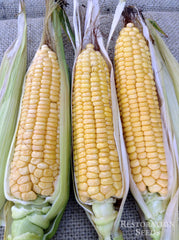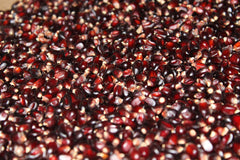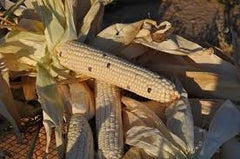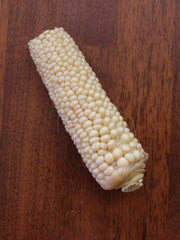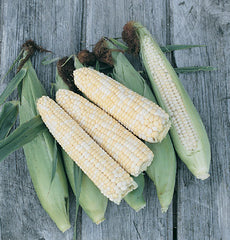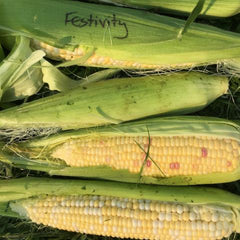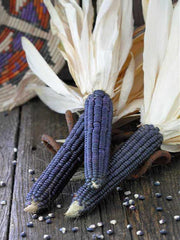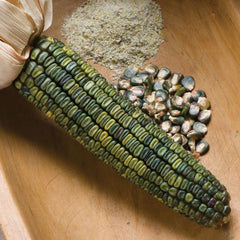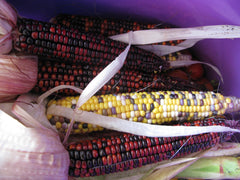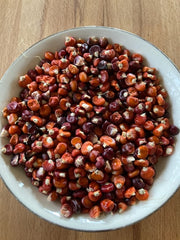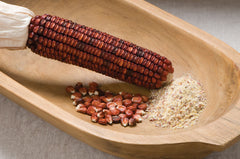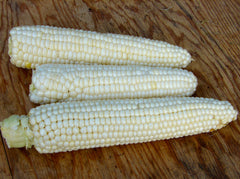Glass Gem
"Zea maysDays from maturity calculated from the date of seeding. Average 120–156 seeds per ounce, about 10–15 pounds per acre. Federal germination standard: 75%. Usual seed life: 5-10 years. Isolation distance for seed saving: 2 miles.
Planting Depth 1-2”
Soil Temp. Germ. 55–65˚F
Days to Germ. 4-12
Plant Spacing 8”
Row Spacing 30”
Days To Maturity 110–120
Full Sun, Moist Well Drained
Glass Gem Seed Count
.25 Pound ≈ 616 seeds
1 Pound ≈ 2,465 seeds
- 100 Seeds$4.10
- 1000 Seeds$18.50
This remarkable rainbow corn is 'Carl's Glass Gems,' selected by Native American corn expert Carl Barnes of Oklahoma. Carl is now in his eighties and lives with his son, A.V. Barnes, on their original homestead in the panhandle of the state, a few miles south of Liberal, Kan. Carl is of half Cherokee, half Scotc...
This remarkable rainbow corn is 'Carl's Glass Gems,' selected by Native American corn expert Carl Barnes of Oklahoma. Carl is now in his eighties and lives with his son, A.V. Barnes, on their original homestead in the panhandle of the state, a few miles south of Liberal, Kan. Carl is of half Cherokee, half Scotch-Irish ancestry and was born in the family’s original farmhouse about a half-mile from his current home. His father had moved the family west, where they acquired land and set up farming on the High Plains. Carl spent his childhood on this homestead, and the family lived through the 1930s Dust Bowl years, staying to survive the ordeal rather than leaving as many did at that time in our history. Carl went on to earn a degree in Agricultural Education, and later in his adult years worked with the Cooperative Extension Service.
In the course of growing some of the older corn varieties still being farmed at that time, Carl began noticing ancestral types of corn re-appearing in his crops. As he isolated these, he found many of the variants to match up with traditional corns that had been lost to many of the Native tribes – particularly those peoples who had been relocated during the 1800s to what is now Oklahoma. Thus, he was able to re-introduce specific corn types to the elders of those tribes, and this helped their people in reclaiming their cultural identities. To those that he met, he became known by his spiritual name, White Eagle.
The rainbow corn was derived from his crossings of Pawnee miniature corns with an Osage red flour corn and also another Osage corn called ‘Greyhorse.’ This was probably during the late 1980s. I once asked him where it really came from and he just replied, “Spirit.”
Released in 2008 Bill McDorman of Native Seeds/SEARCH in Tucson, AZ. Selection by Greg Schoen, “The seed from the ‘Glass Gems’ ear seen in the photo was blended back into the best of the other seed that was sown in the 2008 planting. I have made it a practice to select and plant from as many ears as possible and blend them, rather than plant seed from a single ear or just a few. This is to keep the gene pool broadened while at the same time making selections for certain color tones. Aside from this, no formal plant breeding techniques have been applied with this corn since Carl Barnes.”
”All of these colors and qualities are contained in the diversity of this same general line of corn and in my experience, the different colors and patterns are quite responsive to simple selection from one year to the next. For example, ears with exclusively sky blue, emerald green, pink or the full spectrum of colors can be grown after two or three years. The sky blues tend to appear more readily. Again, seed is selected from as many ears with the desired traits as possible. For seed-saving purposes, for corn specifically, it is ideal for the planting to have at least 200 to 300 plants to maintain the full genetic library of the seed you are starting with.”
”The colors appear most intensely at harvest, due to residual moisture, but persist as the ears become completely cured. Although this corn is enjoyed for its beauty, it is completely edible. It exhibits a range of popcorn and flint corn grain characteristic, and although the popping is only marginal (and the colors do not survive the process), the grain can be ground into flour and used like any other cornmeal. Eating this corn off the cob would be possible if the corn is picked when early and soft.”
Mother Earth News, “The Origins and Journey of 'Carl's Glass Gems' Rainbow Corn” by Greg Schoen, 12/13/2012.
Tags: Type: Flour, Color: Multi Color, Certification: Organic.Corn has been cultivated for at least 5,000 years probably originating in the lowlands of western Mexico. Maize geneticists believe that 90 percent of breeding work in corn had already been done by the time Columbus arrived to find large fields of corn being grown on the island of Hispaniola in 1492. Modern sweet corn most likely descends from flint corns of the northeastern U.S. The sweet corn gene (sugary1, su1) was selected by Native American in at least four additional locations: highlands of Peru, central plateau of Mexico, northwestern Mexico southwestern U.S. and the northern Great Plains. Corn types are sweet corn, starch, parch, flint, dent, popcorn and ornamental. Corn types are sweet corn, starch, parch, flint, dent, popcorn and ornamental.
Native Americans planted corn when the gooseberry bushes were almost in full leaf. They cultivated about 18” diameter, pulled up last year’s dead roots in the spring and formed a hill. Six to eight seeds were planted in the center 9”. Later more earth was hilled up to cover the roots to protect them from the summer sun. Hills were 4’, far enough part so the leaves of mature plants would not touch. Beans and squash were planted after the corn. Beans were planted diagonally between the corn hills across the whole field. Squash was planted in rows outside to separate from the neighbor’s field. Four squash seeds were planted in pairs into opposite sides of a 15” diameter hill.
Companions: squash, pole beans, sunflowers, pumpkins, peas, cucumbers, potatoes, marigold
Inhibitors: tomatoes
Meet Your Farmer
We promote fair trade, organic practices and environmental responsibility throughout the Restoration Seeds supply chain. Below are the family farmers and seed suppliers who bring our open pollinated seeds to you.

